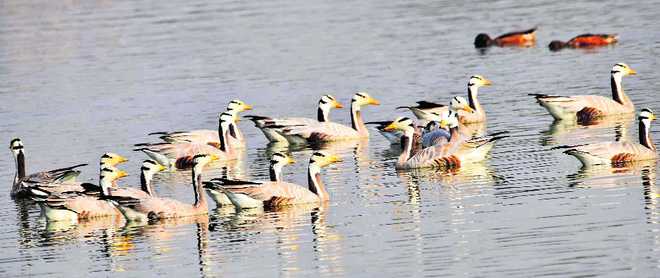If migratory birds could say words, they could have asked for poetic justice. Humans have served a notice on their natural habitats – thousands of miles across the borderless realm ordained by Mother Nature. Jhajjar’s Bhindawas Bird Sanctuary has itself to blame. The once favourite habitat now has an overgrowth of water hyacinth in its lake forcing many winged guests to shift their winter abode to nearby villages.
The Bhindawas wetland is spread over 1,074 acres and was declared a wildlife sanctuary in 1986. It is one of the biggest bird sanctuaries in north India.
The sanctuary is inadequately fenced. Surveillance is limited to lethargic manual monitoring. Beer and other beverage bottles and cans are littered along the lake bank. Environmentalists say hyacinth not only diminishes the availability of food for the migratory birds but also poses a serious threat to their habitat. A dozen surrounding villages have water-logged ponds where these birds take shelter. “Climate change in the last two decades is the other prominent reason that has affected the natural migration of these birds to the region. Excessive urbanization, industrialization and deforestation are changing the micro-climate affecting the sensitive birds,” said Sunder Sambharya, District Forest Officer (DFO).
Jai Bhagwan, Inspector (Wild Life) confirmed a decline in migratory birds in the past two years. But he denies water hyacinth has led to the dwindling number. “Several species of migratory birds use water hyacinth as their food. So, that cannot be the only reason,” he said. He says thousands of migratory birds have developed their permanent habitat in the bird sanctuary and nearby areas.
Sambharya said the habitats of both migratory and local birds were gradually vanishing following intensive agricultural activities and excessive pressure on meagre wastelands. “Rapid industrialisation means more emission of carbon dioxide that squeezes up the nitrogen level threatening vital vegetation consumed by migratory birds. The lack of food sources leads to birds’ migration to a large extent,” the DFO asaid.
Ponds and water bodies such as drains have been auctioned for fish cultivation in many villages. Such people use air guns, crackers and other means like netting of ponds, hanging of polythene sheets across the water bodies to drive away the birds. “If the process continues, the Bhindawas sanctuary will one day become bird-less.” said Sambharya.
The DFO maintained lakhs of birds of various species reached the region in olden days but their numbers and species diversity have gradually gone down. Earlier, lot of white storks, pelican, demoiselle crane and Indian skimmer migrated to Bhindawas and adjoining areas, but these species have not been seen in this region in the past several years.
“Even the number of other bird species like common crane, black stork, common shelduck, mallard, black stork, avocet, river turn and Indian rail is also declining every season. Only some birds of these species are now reported in Bhindawas and its stopover areas of Khaparwas, Bilochpura, Reduwas, Dighal, Dhandalan, Baland and Karontha,” he said.
Unlock Exclusive Insights with The Tribune Premium
Take your experience further with Premium access.
Thought-provoking Opinions, Expert Analysis, In-depth Insights and other Member Only Benefits
Already a Member? Sign In Now










